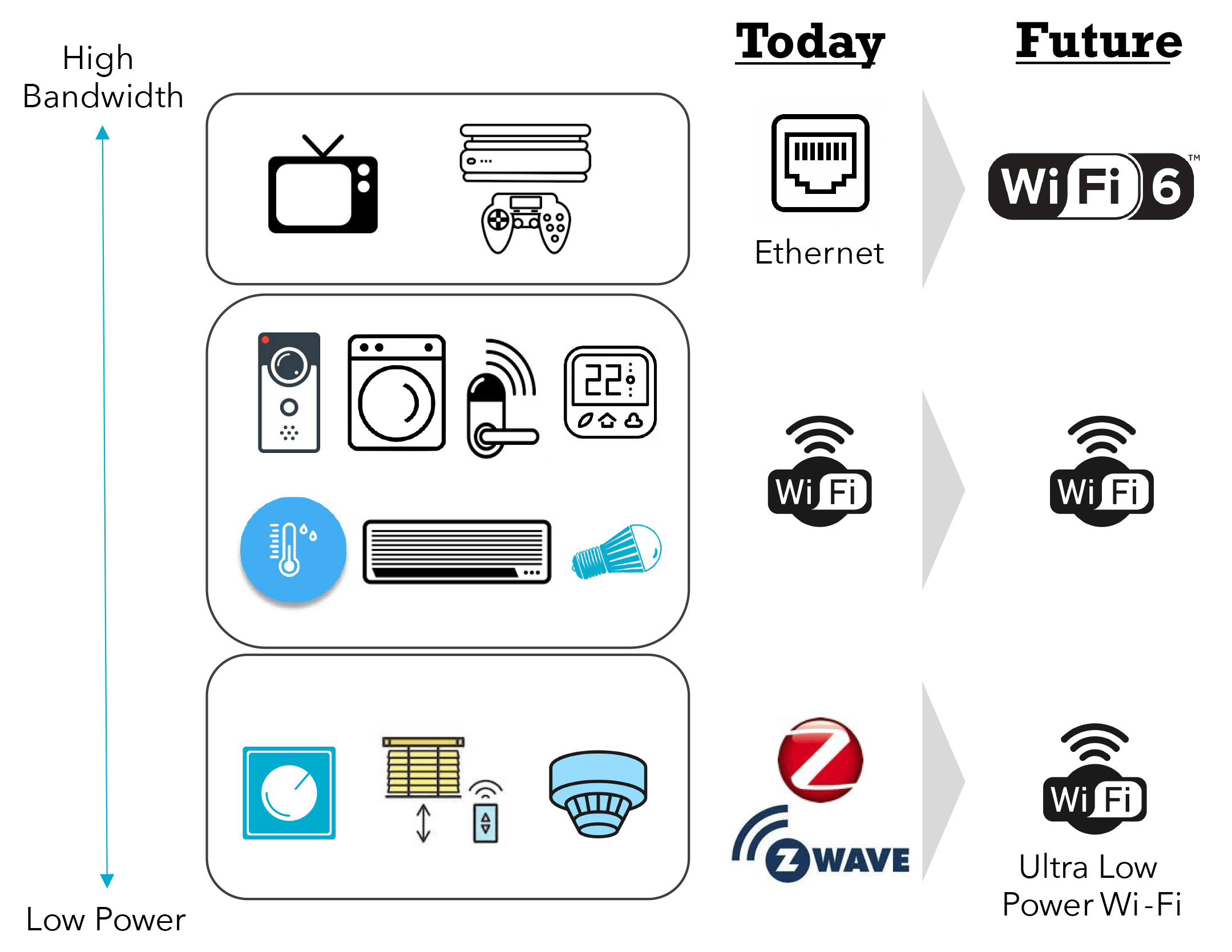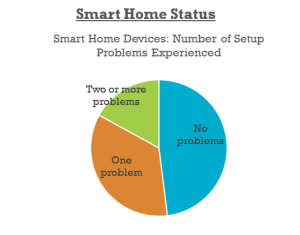The promise of the Smart Home is to simplify life for you. It holds the potential to cook food, order groceries, schedule housework, and monitor the premises, providing you with comfort, convenience, safety, and security. But the reality is far from the promised vision.
Why is Smart Home Technology Not There Yet?
In developed countries, between 5-15% of homes have adopted some sort of smart home product (source: Statistica). These penetration rates place the smart home in the early phase of adoption. Early adopters are usually technology-driven professionals who love technology for the sake of technology. They are willing to go through complicated setups and are patient enough to work through early bugs and setbacks.
The early majority, on the other hand, is not focused on the novelty of the technology but is driven by its usefulness. Technology is adopted by the early majority if it is easy to set up and provides a tangible benefit to the end user.
But today’s smart home is complicated to set up if you are not a tech-savvy person. While you can easily purchase a mobile device or a laptop and know it will connect to your home’s Wi-Fi network without any issue, you cannot do the same with a smart home gadget.
According to Next-Generation Support: Building an Engagement Platform, more than 50% of smart devices face setup problems during installation. In other words, if you want to install 10 smart devices in your smart home, there is a 99.94% probability that you will face at least one setup problem. That is simply unacceptable for the mass adoption of smart home devices.
Number of setup problems experienced during setup
Most setup problems are rooted in the protocol fragmentation problem of the smart home. In today’s smart home, Wi-Fi and Ethernet are used for high bandwidth applications, while Zigbee and Z-wave are used for low power use cases. Zigbee protocol has fragmentation issues as two Zigbee versions are not compatible with one another. Z-wave is a proprietary protocol that commits manufacturers and users to one supplier.
Setting up a smart home with these protocols requires an expensive hub that makes inter-device communication possible. The problem with that is not only the cost for the end-user but also the fact that the manufacturers of these hubs control the data of smart homes. Hub manufacturers may decide to limit access by introducing unexpected subscription fees or similar barriers and occasionally high-profile hub manufacturers have encountered financial difficulties, leaving end-users stranded. In short, a hub-based home architecture makes mainstream adoption complicated.
Wi-Fi Will Simplify the Smart Home
Wi-Fi is the ubiquitous protocol for the smart home. It is installed in almost every home in the developed world. It is easy to set up and easy to maintain. With the emergence of Wi-Fi 6 and low-power Wi-Fi, the protocol fragmentation problem of a smart home can be potentially addressed now. Wi-Fi 6 will replace the high bandwidth applications that are currently run on Ethernet today while new ultra-low power Wi-Fi platforms such as Renesas’ DA16200 will replace Zigbee and Z-Wave for low power use cases. DA16200 provides the low power benefits of Zigbee and Z-wave while maintaining the compatibility, simplicity, and ubiquity of standard Wi-Fi. With the DA16200 Wi-Fi platform, embedded developers can enable one year of battery life or more for their IoT devices even for always-connected scenarios.

How Wi-Fi will simplify smart home architecture
The DA16200’s leadership in the ultra-low-power Wi-Fi market is evidenced by receiving the highest score on the EEMBC IoTMark [Wi-Fi] benchmark. Thus, the smart door lock will last for more than three years on a single charge - a period up to 50% longer than its closest competitor.
What is the Magic Behind Renesas’ Ultra-Low Power Wi-Fi?
DA16200, the ultra-low power Wi-Fi platform, is based on Renesas’ VirtualZero™ Technology. Renesas’ talented and dedicated engineers have mastered the art of low-power Wi-Fi with the development of patented proprietary DPM algorithms, which use many of the features of standard Wi-Fi to optimize sleep and wake-up times. This platform offers three different sleep modes to be used depending on the requirements of IoT device manufacturers.
- Sleep 1 operates at the lowest power with 0.2µA current. When this sleep mode is activated, most of the chip blocks turn off and the chip is disconnected from the network. An external interrupt that runs through the chip’s wake-up pins or its digital and analog IOs can turn on the SoC.
- Sleep 2 allows the device to retain its real-time clock functionality while only consuming 1.8µA. It also guarantees a wake-up time of less than 100ms to respond to outside events or the completion of the internal timer.
- Sleep 3 enables always-connected Wi-Fi mode and ensures a wake-up time of less than 2ms if it detects an incoming Wi-Fi packet. This mode consumes less than 50µA average current. In this mode, the SoC performs periodical checks for standard Traffic Indication Map (TIM) or Delivery Traffic Indication Map (DTIM) information elements embedded in 802.11 management frames. It also wakes up to initiate the process of normal Wi-Fi traffic, just like any network station does when it’s required.

Benefits of VirtualZero Technology
Simple and Fast Wi-Fi Implementation
In developing their first IoT product, our customers usually consider the time it takes to market as a key factor. The majority of these customers have limited knowledge of Wi-Fi stacks since their primary objective is to add value at the application level rather than waste their resources on complex implementations. That’s why we provide our customers with easy-to-use SDKs and a range of corresponding tools to help them develop Wi-Fi products faster and more efficiently. AT Command is one example of such a tool.
We have developed a comprehensive set of AT commands on our wireless DA16200 platform to assist our customers in rapidly developing and deploying their IoT applications. Additionally, Wi-Fi provisioning, GPIO configuration, and Firmware Over-The-Air (OTA) updates are supported by the DA16200 AT command tool. If any customization requirements exist, developers can create their own commands. The AT Command parser and examples utilizing UART and SPI are available, and you can reuse them for the microcontroller of your choice. The Raspberry Pi RP 2040 and STM 32 running examples are available. Third-party boards such as the MikroE LP WiFi Click board, Qwiic WiFi Shield and SparkFun MicroMod WiFi Function Board will help you speed up the development of your next Wi-Fi wirelessly connected IoT application.
We've also included a Wi-Fi provisioning app along with license-free example source code for both iOS and Android. The full AWS IoT services are integrated and give you the option to deploy and redevelop your own application. To speed up prototype development, the DA16200 development kit supports FreeRTOS development and GCC-based development.
Summary
Low power Wi-Fi technology is key to making the smart home network a lot simpler by eliminating the need for an expensive hub and solving the issue of protocol fragmentation. Renesas is disrupting the smart home industry with its low power Wi-Fi technology. The DPM algorithms, based on patented VirtualZero technology, allow IoT devices to have a year of battery life or even more. The comprehensive set of AT commands provides developers the flexibility to customize, deploy, and redevelop for their unique application. These key qualities make Renesas’ Wi-Fi a great alternative to both Zigbee and Z-wave. Contact us now to learn more about how you could join the future of the smart home.
For more information see the DA16200 page on our website.

